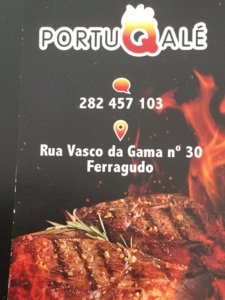Newsletter July 2021
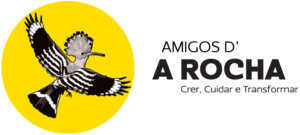
 Welcome to our July Newsletter 2021
Welcome to our July Newsletter 2021
Thank you for supporting us !
Summer is here! 😊
Helen & Filipa
S
N
A
P
SHOT

José Saramago

Portuguese writer, Noble Prize in Literature in 1998
Born: 16th November 1922, Golegã, Portugal
Died: 18th June 2010, Canary Islands, Spain
José Saramago was born in Azinhaga village in Golegâ, into a farming family. Most of his life was spent in Lisbon where he moved when he was 2 years old. Due to economic reasons, he was unable to study in high school, he did a professional course, and his first job was a blacksmith. His interest in books started and he became a frequent visitor to the public library, guided by the curiosity and the will to learn, he developed a self-knowledge in literature. He had many jobs including public agent, translator, journalist, and sub-director of the Diário de Notícias Journal. Saramago was not his family name, but the “nickname” that his family was known as in the village, meaning a plant common in the area; by the time his parents went for his registration the person in charge wrongly gave him the “nickname” as his family name.
In 1947, José Saramago, at 25 years of age, publishes his first book, “Sin’s Land” (Terra do Pecado), and six years later he finished his second book “Skylight” (Clarabóia), which was only published after his death. After some years with no publishing, he starts writing poetry and publishes in 1966 “The Possible Poems” (Os Poemas Possíveis), in 1970 “Probably Happiness” (Provavelmente Alegria) and in 1975 “The year of 1993” (O Ano de 1993). The years he worked as a journalist, editorialist, and sub-editor at several newspapers, he left four chronicles (Deste Mundo e do Outro, 1971; A Bagagem do Viajante, 1974; As opiniões que o DL teve, 1974 and Os Apontamentos, 1976). In 1976, José Saramago decided to be a full-time writer and in 1980 he published “Lift up from the floor” (Levantado do Chão) a book about the poor workers in Alentejo, and in which he defines his way of writing. “Convent’s Memorial” (Memorial do Convento), published in 1982, was the book that launched José Saramago in the literature world as a fiction writer. He then became a nonstop writer of fiction romances in which he questions/criticizes and metaphor the capitalist society, religion, human existence and even death. Some of his most famous books, translated all over the world: “The year of the death of Ricardo Reis” (O Ano da Morte de Ricardo Reis), 1985, The Stone Raft (Jangada de Pedra),1986, “The Gospel According to Jesus Christ” (O Evangelho Segundo Jesus Cristo), 1991, Blindness (Ensaio sobre a cegueira), 1995, The Double (O Homem Duplicado), 2002.
José Saramago received the Camões Prize in 1995 and the Nobel Prize in Literature in 1998. In 2007 a Foundation was created in his name in Lisbon, for the dissemination of Literature, and the defense of human rights and the environment. He died in 2010 in Lanzarote where he was living with his wife, Pilar del Rio.
IFO’s – Identified Flying Objects…
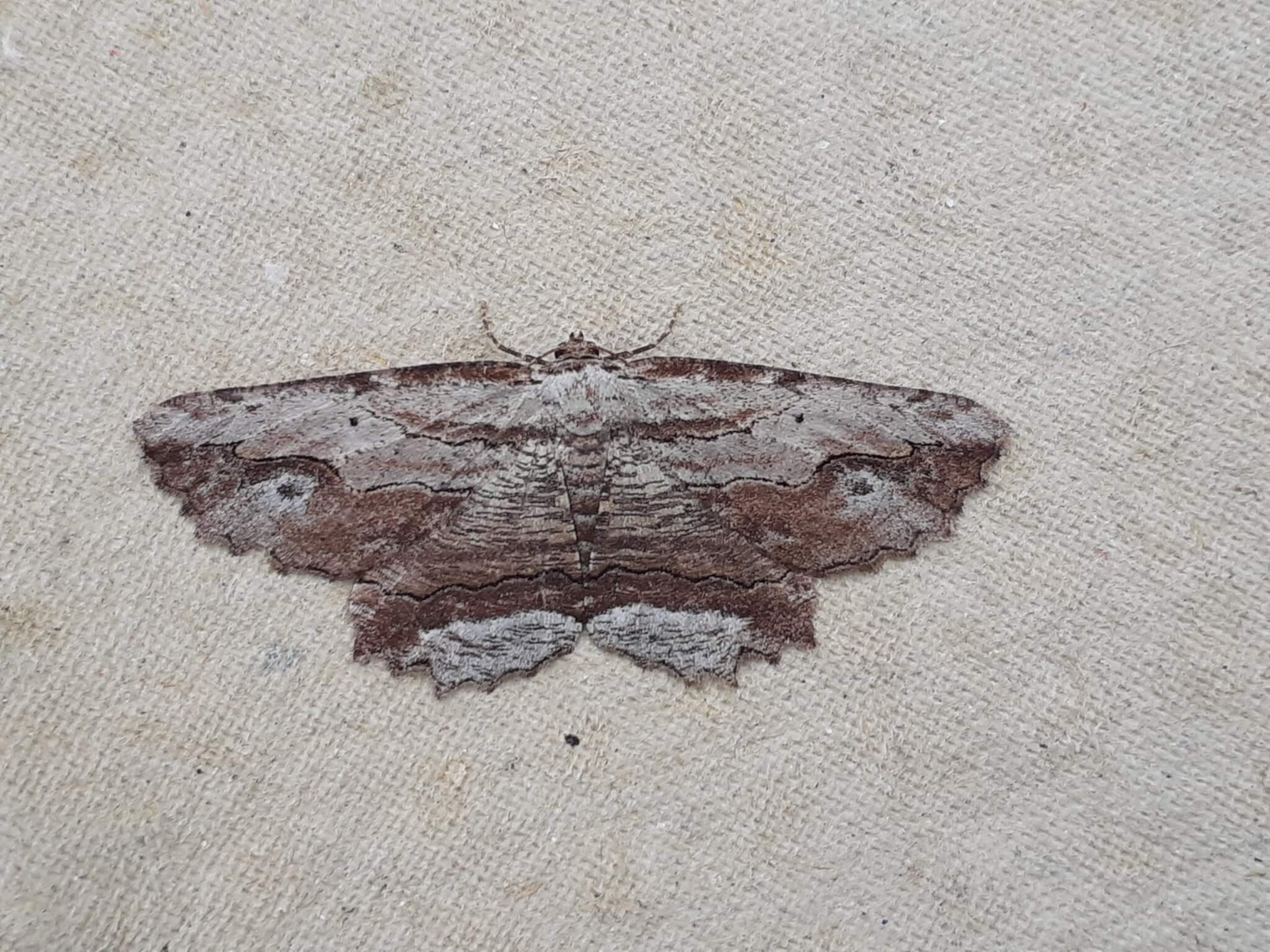
Waved Umber
(Menophra abruptaria, Thunberg, 1792)
Photo by Filipa Bragança

Morphology: It is a macro moth from the Geometridae Family, with a wingspan between 36 and 42 mm. The ground colour of the upper side of the wings varies from whitish brown to tawny brown, the forewings have a distinctive dark marking above the tip of the wing; the hindwings have a dark brown concave band; the markings are parallel (resembling fissures on a wood surface). The wings are open when resting. The adults fly from April to June. Usually only one generation per year but can have two (July/August).
Habitat: woodlands, gardens, parks, and farmlands.
Distribution: North Africa, Southern Europe, and Asia Minor; in Northern Europe can be found in the British Islands (South) to Switzerland and South-western Germany.
Notes: The larvae host plants include the Garden privet (Ligustrum ovalifolium), Lilac (Syringa vulgaris) and Ash (Fraxinus sp), species belonging to the Oleaceae Family. Hibernates as a pupa.
Tweet… Tweet…


Eurasian Coot
(Fulica atra, Linnaeus, 1758)

Photo by Filipa Bragança
Identification: It’s an aquatic bird from the Rallidae Family, between 36 to 42 in length. The plumage is all black, the bill and the frontal plate are white, has rounded body with short tail. Males and females are alike, the juveniles have brownish plumage with whitish sides of the head, neck, and breast.
Habitat and Ecology: In Spring they can be found in coastal lagoons, marshlands, and reservoirs, in winter they can be found on a wide variety of habitats, like dams, lakes and artificial lagoons on golf courses. It is an early breeder (showing territorial behaviour from December onwards). This species is omnivorous but feeds mainly on vegetable matter.
Distribution: Wide distribution, Europe, Africa, Asia, and Australia. In Portugal it is more common in the South and Centre Coastal Region. This species is a resident and a winter bird, some of the Northern populations spend winter in Portugal. In Ria de Alvor it is present mainly in the winter.
Threats and Notes: Least Concern (LC) in the International Union for Conservation of Nature (IUCN) red list, the major threats are hunting, poison and pollution. In Portugal this is a hunted species. The population suffered a small decline during the twentieth century, it seems that it is increasing and expanding in the last years.
DID YOU KNOW? 
-
A Rocha Portugal team takes part on the Coastwatch project, a citizen science European project and environmental volunteering, which aims to monitor the Portuguese beaches and collect the marine litter and information about the fauna and flora existing in the area. In Portugal, this project is coordinated by GEOTA (Study Group of territory ordering and environment). A Rocha took part in this project from 2003 to 2009 and restarted this year again, also with the help of some volunteers. More info here
-
A Rocha Portugal is in the dunes! The environmental team of A Rocha Portugal is working with kids from Lagos school to raise awareness of the importance of the dunes as unique ecosystems. See facebook of Gil Eanes School here (only available in Portuguese)
-
Paula Banza is a secondary biology teacher for many years now and recently she finishes her PhD in moth pollinator networks. This year she is working at A Rocha Portugal with a special governmental program which allows teachers to work out from the schools for a specific period. Paula is working for several years now with moths; recently she wrote a very interesting article for the A Rocha International Blog, titled “Playing God? Deciding which species should live and die”. Read the full article here
- A Rocha Portugal Butterfly Monitoring Program. Watch the video
- Have you walked on the boardwalk in Alvor? or on the beach towards the estuary? Probably you saw some information boards,
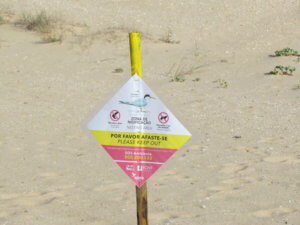 yes it is true, the Little Tern (Sternula albifrons) and the Kentish Plover (Charadrius alexandrinus) nest there, building their nets in the dunes. There are species more vulnerable at this time of the year and to ensure their breeding success it is important not to disturbed them. The ICNF (Conservation Institute for Nature and Forests), SPEA (Portuguese Society for the Bird Study), the Portimão Council and A ROCHA Portugal work together for the Conservation and Protection of these bird colonies, placing information boards so people are aware and do not disturb the birds. It is important that dogs are not allowed to run through the dunes at breeding times.
yes it is true, the Little Tern (Sternula albifrons) and the Kentish Plover (Charadrius alexandrinus) nest there, building their nets in the dunes. There are species more vulnerable at this time of the year and to ensure their breeding success it is important not to disturbed them. The ICNF (Conservation Institute for Nature and Forests), SPEA (Portuguese Society for the Bird Study), the Portimão Council and A ROCHA Portugal work together for the Conservation and Protection of these bird colonies, placing information boards so people are aware and do not disturb the birds. It is important that dogs are not allowed to run through the dunes at breeding times. - A Rocha was invited by the Municipality of Lagos to participate in the Inauguration of the Project “Gobi- what eats the fish?” at Praia da Luz, on the 7th of June. This is a global project to raise awareness for holiday makers and the general public about the amount of plastic waste that we accumulate in our day-to-day lives and invariably ends up in rivers and oceans. This project began last year on the Bandeira Azul beaches with the installation of a metal structure in the shape of a giant fish, where each person can deposit their plastic waste. To help us we had the company of our volunteers from Saint Vincent’s church who diligently deposited their plastic rubbish and, in the hours, before helped to collect the rubbish on the beach with us.
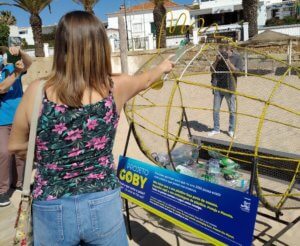
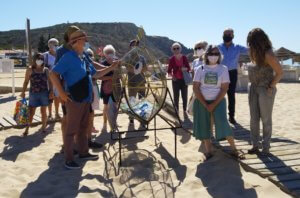 Text and photo by Isabel Soares.
Text and photo by Isabel Soares.
- Finally! The main wall at the Alvor estuary is almost repaired, soon it will be possible to walk around the estuary and bird watch!
- June has been a quite month for birds at Cruzinha Ringing Station, although there were some interesting catches: a juvenile Blackcap (Sylvia a tricapilla), a bird very common in winter, in our ringing station but not in spring/summer, and a Crested Lark (Gallerida cristata), a very common bird in the area, but rare to find one in our ringing nets!
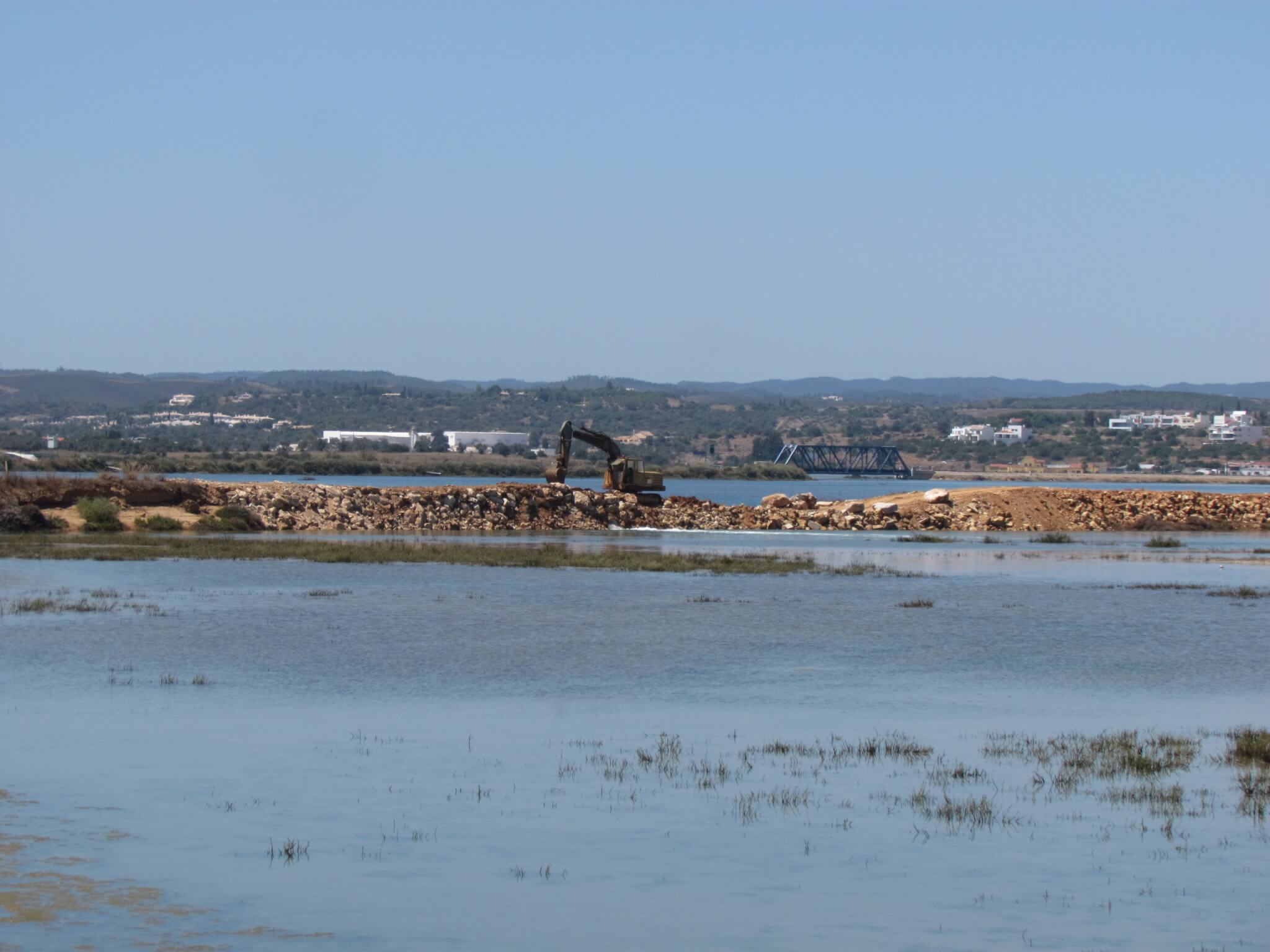
Alvor Estuary

Crested Lark (Gallerida cristata)


 The Algarve is not just sea! The mountains, not very high, are also an interesting place, and when it is very hot it is possible to find some coolness there. Monchique is the highest point in the Algarve and has a wonderful view! I always get a little bit disappointed when I visit Monchique… but I always keep going 🙂 The road is surrounded by trees, most of which are invasive or exotic species like the Mimosa or the Eucalyptus, or even the Linden Tree (Tilia sp) (an exotic species native from Europe but not from Portugal). Some of the hills are still “naked”, the result of the last big fires… Wildlife is still present in places on the small remaining habitats. Here and there it is possible to see some native species like the Chestnut Tree or the Cork Oak Tree. In fact the most beautiful places are hidden and need to be discovered… I was lucky to see Paeonia broteri a Peony endemic species from Iberia Peninsula. In every visit I discover another reason to come back. On a small walk to Fóia, I saw a small but lovely waterfall; the roadsides had beautiful pink flowers, the Foxgloves (Digitalis purpurea) and it was possible to hear the Rock Bunting (Emberiza cia)! I still managed to photograph a wonderful moth, Zygaena lavendulae!
The Algarve is not just sea! The mountains, not very high, are also an interesting place, and when it is very hot it is possible to find some coolness there. Monchique is the highest point in the Algarve and has a wonderful view! I always get a little bit disappointed when I visit Monchique… but I always keep going 🙂 The road is surrounded by trees, most of which are invasive or exotic species like the Mimosa or the Eucalyptus, or even the Linden Tree (Tilia sp) (an exotic species native from Europe but not from Portugal). Some of the hills are still “naked”, the result of the last big fires… Wildlife is still present in places on the small remaining habitats. Here and there it is possible to see some native species like the Chestnut Tree or the Cork Oak Tree. In fact the most beautiful places are hidden and need to be discovered… I was lucky to see Paeonia broteri a Peony endemic species from Iberia Peninsula. In every visit I discover another reason to come back. On a small walk to Fóia, I saw a small but lovely waterfall; the roadsides had beautiful pink flowers, the Foxgloves (Digitalis purpurea) and it was possible to hear the Rock Bunting (Emberiza cia)! I still managed to photograph a wonderful moth, Zygaena lavendulae!
Filipa
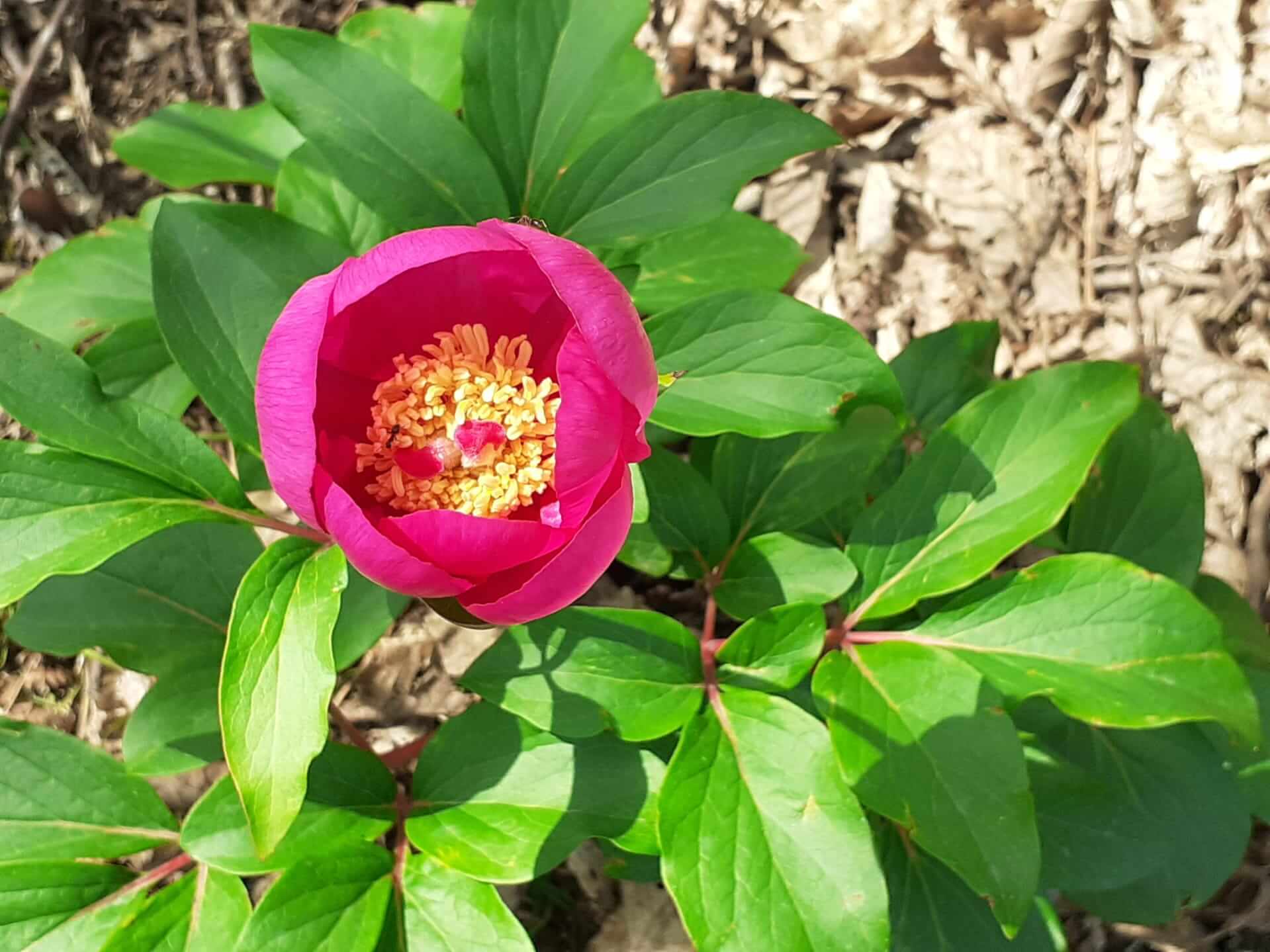
Paeonia broteri

Foxgloves (Digitalis purpurea)

Zygaena lavendulae
 INVASIVE SPECIES
INVASIVE SPECIES
Asian Giant Hornet (Vespa velutina, Lepeletier, 1836)
Phylum: Arthropoda 
Class: Insecta
Order: Hymenoptera
Origin: Southeast Asia (tropical and sub-tropical areas: northern India, east China, Indochina, and Indonesia)
Size: 17 to 32 mm (queen- 30 mm, males-24 mm, worker bee-20 mm)
The Asian Giant Hornet is a wasp a little bit smaller than the European Hornet (Vespa crabro). The colour is mainly dark with an orange band in the 4th segment of the abdomen and a yellow stripe in the first segment, the edge of the abdomen is dark, the head and thorax are dark; when seen from the front, the head is orange and the legs yellow.
In the Spring, the queen builds the primary nest on its own, usually in a protected place; the nest is rounded with a 5 to 10 cm diameter. At the end of spring or beginning of summer the colony of wasps builds a secondary nest in a high and isolated place, like the top of a tree or a high building, this nest is bigger and has a pear shape with a lateral opening. The secondary nests can have thousands of wasps and some of them will build new colonies the following spring. The Asian Giant Hornet is carnivorous and feeds mainly on bees, it is a predator of the Honeybee (Apis melifera); usually settles down in urban or close to urban areas.
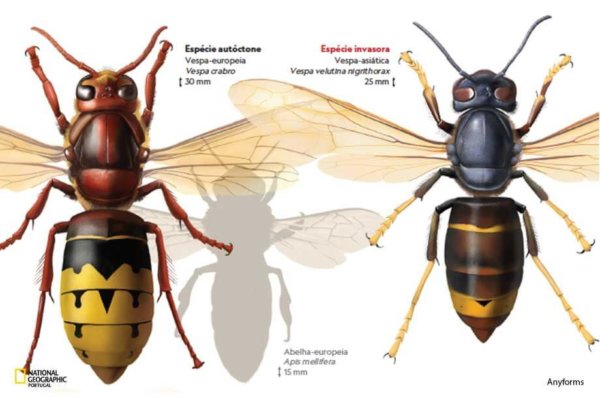 In Europe there is a subspecies: Vespa velutina nigrithorax, which lives in the North of India (Darjeeling, Sikkim), Bhutan, China and the mountains of Sumatra and Sulawesi (Indonesia). This subspecies was introduced to Europe through a maritime way, it is thought that they arrived in France with a load of Bonsai from China, in 2004, and spread very quickly all over the country. This Hornet was reported in Spain in 2010, in Portugal and Belgium in 2011 and in Italy at the end of 2012; recently was reported in Germany and in the United Kingdom. The Asian Great Hornet was also introduced in South Korea (2003) and it is considered an invasive species.
In Europe there is a subspecies: Vespa velutina nigrithorax, which lives in the North of India (Darjeeling, Sikkim), Bhutan, China and the mountains of Sumatra and Sulawesi (Indonesia). This subspecies was introduced to Europe through a maritime way, it is thought that they arrived in France with a load of Bonsai from China, in 2004, and spread very quickly all over the country. This Hornet was reported in Spain in 2010, in Portugal and Belgium in 2011 and in Italy at the end of 2012; recently was reported in Germany and in the United Kingdom. The Asian Great Hornet was also introduced in South Korea (2003) and it is considered an invasive species.
The reproduction strategy of this species, marked with a higher breeding success comparing with other wasps and the higher ability of dissemination, make the Asian Great Hornet a danger, not just for other bee species, biodiversity, and for agriculture and public health (can attack in a group when threatened). The honey production is also affected because the presence of the Asian Great Hornet decreases the activity of the Honeybee and can even cause the destruction of all the hive, indirectly this can affect the agriculture because the Honeybee is an important pollinator.
In Portugal the Asian Great Hornet is present in the North and Centre Regions. In 2018 a plan for surveillance and control was implemented of the Asian Great Hornet “STOPvespa” coordinated by the ICNF (Nature and Forests Conservation Institute) where citizens can register online the sightings of this species.
POPPED UP

Family: Oleaceae
Identification: It is evergreen shrub, up to 3 metres heigh. The crown is thick and rounded, with one or more stalks branched growing from the base; the branches are long and flexible; the leaves are green, opposite, simple, leathery, and slender. The flowers are small, whitish, and grow in small clusters at the base of the leaves. The fruits are rounded drupes, dark bluish when mature. Flowers from February to April.
Habitat and distribution: Cork oak woodlands and dry shrublands, sunny places with poor and rocky soils. Native from the western Mediterranean basin: Italy and Islands, France, Spain and Balearic Islands, Portugal, Algeria, Morocco, and Tunisia.
Notes: The plant is used for ornamental purposes in gardens, because it is very tolerant to the dry and maritime conditions. The fruits are eaten by birds and are an important food resource in autumn, although they are poisonous to humans. The plant can live up to 100 years.
Narrow-Leaved Mock Privet
(Phillyrea angustifolia) (L.)
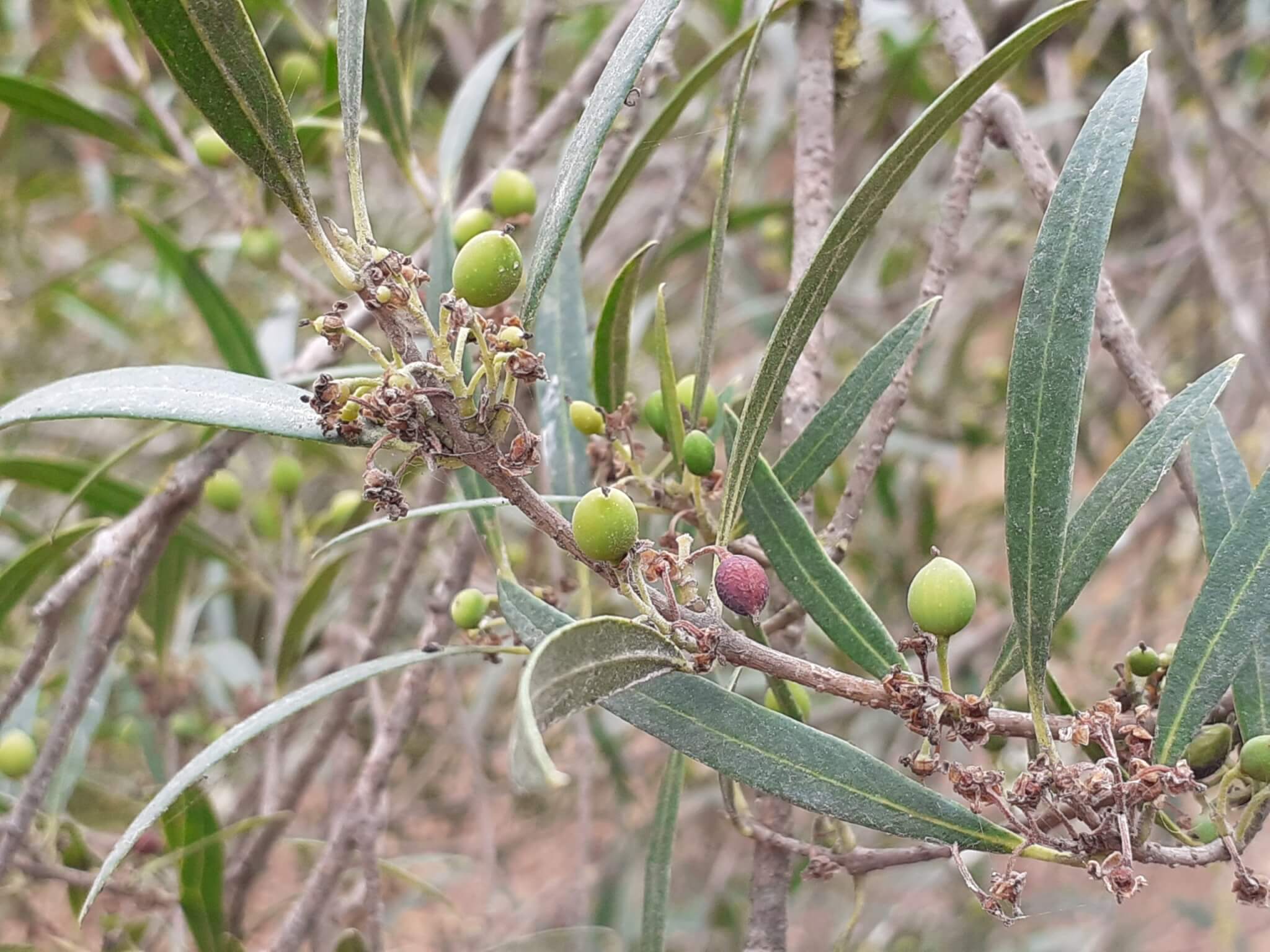
Photo by Filipa Bragança
DATES TO REMEMBER

3trd July – International day of NO plastic bag usage
1st, 8th, 15th, 22nd and 29th July- Cruzinha Bird ringing display & Moth Talk (10.15am to 12 am). Book here
28th July – Nature Conservation Day
30th July – International Friend’s Day
Thank you for supporting the Friends of A Rocha Portugal

Dr Roy Rodrigues
Av. Do Brasil, Qta das Palmeiras, Lt P2, R/c A, 8500-299 Portimão
(+351) 282180683
royaldente@gmail.com

Sítio da Amoreira, Lote 12,
Alvor, 8500-045 Portimão
(+351) 282412562/ 925433047
www.transfair.com.pt
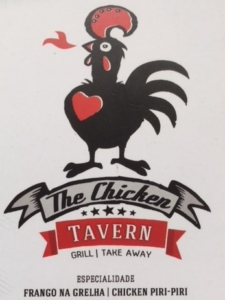
Urbanização Mar e Serra n° 47, Alvor
8500 – 783 Portimão
(+351) 911597735
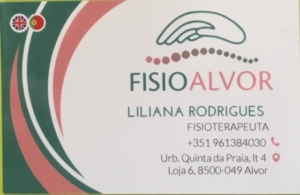
Physiotherapy, Massages (relaxation, sports, therapeutic)
Other therapies
Beauty (manicure, pedicure, hair removal, facials)
Open Monday to Friday
Thought of the month 
“When you do not have what you like, you need to like what you have.” Eça de Queirós (1845-1900, Portuguese writer and diplomat)
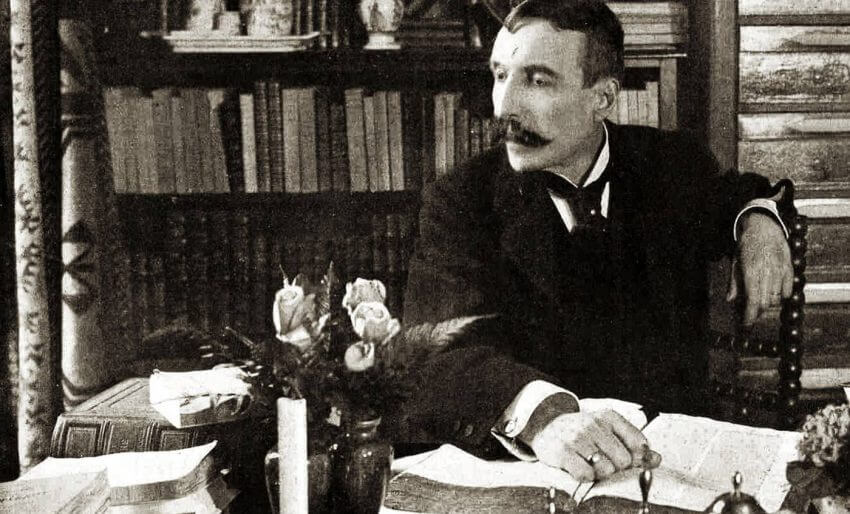
LETS BE GREEN – LETS BE GREEN – LETS BE GREEN 
Efficient driving increases autonomy by 35%! Regular and up-to-date car maintenance reduces gas emissions by 50% and consumes less fuel!
Advice for eco-driving
- Tire pressure should always be right (less pressure on the tires increases the use of fuel by 6%)
- Up-to-date maintenance (a healthy car is a more efficient and economic car)
- Keep your distance (avoid using the brake suddenly)
- Less acceleration (when going down hill do not accelerate, use a high gear, and let it go)
- When possible jump gears (from 3rd to 5th ) you will use less fuel, and the same applies from 3rd to 5th
- Air conditioner (AC uses fuel, avoid using it and turn it off when temperature is ok)
- Traffic-jam (start-stop, turn engine off if you are stopped more than 1 minute)
- Speed (Avoid high speed, drive calmly, using the higher gear and lower rotations)
- Walk, whenever it is possible instead of using the car, walking is also good for your health
LETS BE GREEN – LETS BE GREEN – LETS BE GREEN
Moth report
Since 1991, A Rocha is monitoring moths in the Cruzinha garden. This project aims to discover the diversity, abundance and distribution of moths and the knowledge is also used in Environmental Education activities.
The monitoring consists of a moth trap placed in the garden at night, attracting moths using a light. Since 2007, Dr Paula Banza is responsible for the project. In 2019 there were 34 sessions, 4838 individuals were captured and there were 338 species; in 2020, there were 33 sessions, 7718 individuals were captured and there were 358 species. In both years most of the individuals captured belonged to Noctuidae Family and most of the species identified also belonged to Noctuidae Family.
In 2019 there were 14 new species identified in the area, and in 2020, 16 new species. Some of them were not possible to identify because we were not 100 % sure, it is necessary to do a genitalia analysis to confirm identification (some species have slightly differences in coloration, but genitalia of species are always different, and we do not have that expertise at Cruzinha).
The most abundant species in 2019 were Bordered Ermel (Ethmia bipunctella) and Hoary Footman (Eilema caniola) and in 2020 Hoary Footman (Eilema caniola) and Large Yellow Underwing (Noctua pronuba).
The full report of 2019-2020 is available here, only in Portuguese.
On A Rocha Portugal website you can find moth reports since 2014. See here.
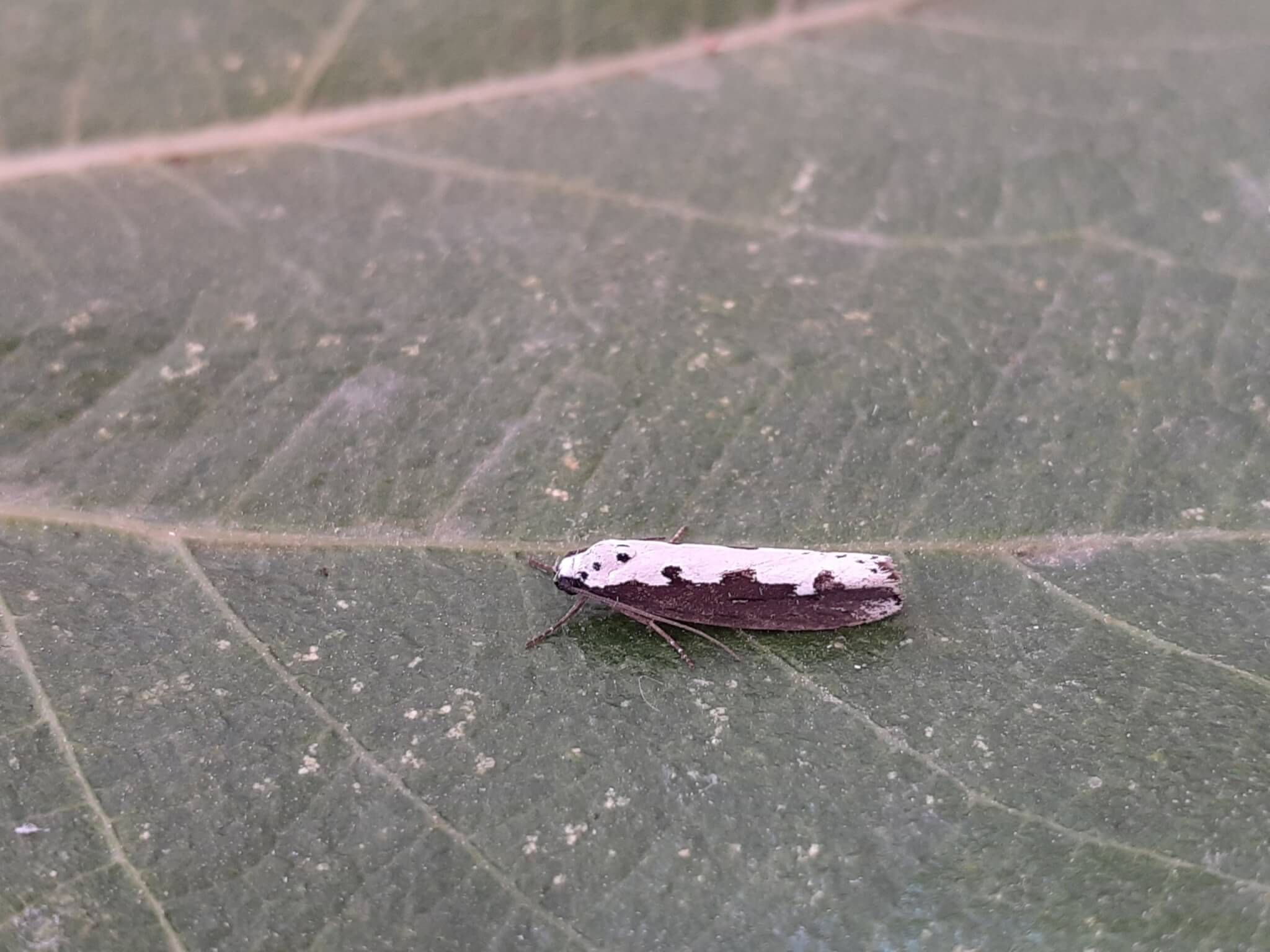
Bordered Ermel (Ethmia bipunctella)

Hoary Footman (Eilema caniola)
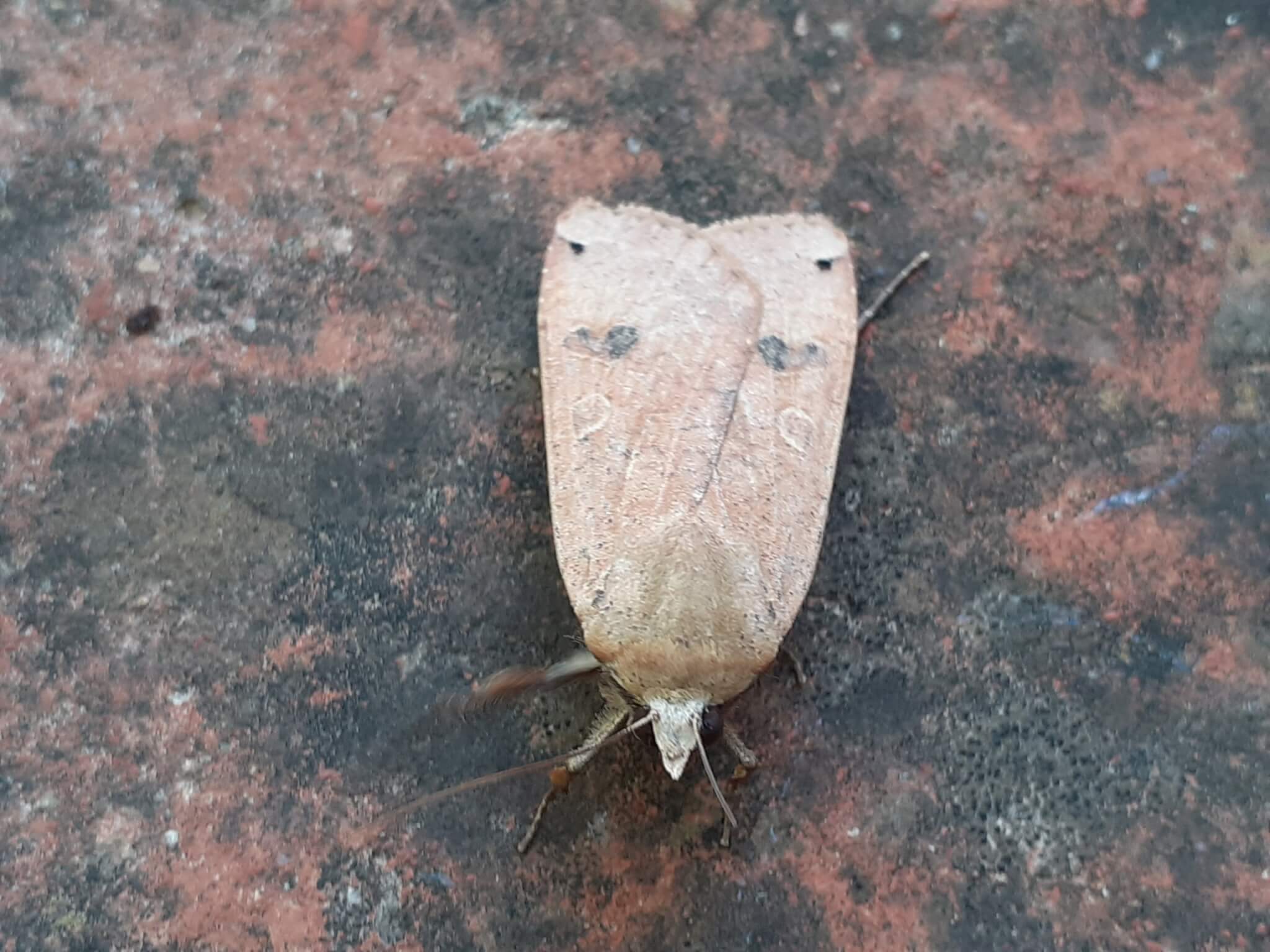
Large Yellow Underwing (Noctua pronuba)
Photos by Filipa Bragança
Sustainability Champions 
Sustainability Champions from around the World– Looking at ways to curb pollution and waste management.
We would like to thank Daniel Hartz, the founder of Sustainability Champions for giving us the permission to share this information.
 Bryan Ware an inventive Dad from California came up with an idea in 2011, when celebrating his son’s 11th Birthday at a restaurant. The waiter had brought his two sons some crayons, and he wondered where the crayons go after they are done with them.
Bryan Ware an inventive Dad from California came up with an idea in 2011, when celebrating his son’s 11th Birthday at a restaurant. The waiter had brought his two sons some crayons, and he wondered where the crayons go after they are done with them.
He discovered they were thrown out and that led him to thinking about what he could do.
He collected the crayons, melted them, and poured them into special custom made molds, he can make 96 new crayons each time he does this. The new crayons are then given to hospitals for children who are patients . His Crayon Initiative has signed up 400 restaurants and 100 schools in several Western States to donate used crayons. He melts these at home on his stove and portable induction cooktops with the help of his sons and his wife, Marissa a school teacher. These crayons are thicker and easier to hold for young children and those with special needs.

Check the website for dates for organised tours
The Spoonbill (Platalea leucorodia)
Some birds are easy to identify because of a special feature. It is the case of the Spoonbill, with its special bill, which also gave it its name.
 It is a local breeding species in the south of Spain and Portugal, but it is more abundant on passage and in winter. The species increased a lot in Europe after a long decrease which had left only 2 colonies, in the Netherlands and the extreme south-west of Andalusia in the mid 20’s. The western European population increased to reach 4,800 pairs and 19,000 individuals in 2007. The Spoonbill has a long story in south-western Andalusia. The species has been breeding at Doñana since 1765 and in Marismas del Odiel and Isla Cristina since 1960. Nowadays, the main Iberian colonies are in western Andalusia: Huelva, Sevilla and Cadiz, some breed in Extremadura, Castille y Leon, Castilla la Mancha and in the southern half of Portugal. The population increased but show interannual variations due to the weather. Since 1996, the average population was 1,400 pairs and reached a maximum in 2001 with 2,700 pairs and a minimum in 1999 and 2005 with less than 300 pairs. A census in 2007 showed that there were 1,614 pairs in Spain and 98.8% were in Andalusia. The population increased 5,5 % annually between 1959 and 2007 but 90% of it remained in only a few colonies in Andalusia which are Doñana, Marismas del Odiel, Marismas da Isla Cristina, and Cadiz Bay. In Portugal, the species bred during the 17th century but disappeared until 1970. It bred again in 1988 with 4 pairs at Paul do Boquilobo (Santarem). In 1996, 43 pairs bred in Portugal in 4 colonies: Paul do Boquilobo, Pêro Peão (Evora), Ria Formosa and Paul de Muge (Santarem). In 2002, a new census showed there were between 92 and 99 pairs in 10 colonies located in the Tagus valley, center of the Alentejo and the Ria Formosa. There is an interannual variation in the number and breeding places.
It is a local breeding species in the south of Spain and Portugal, but it is more abundant on passage and in winter. The species increased a lot in Europe after a long decrease which had left only 2 colonies, in the Netherlands and the extreme south-west of Andalusia in the mid 20’s. The western European population increased to reach 4,800 pairs and 19,000 individuals in 2007. The Spoonbill has a long story in south-western Andalusia. The species has been breeding at Doñana since 1765 and in Marismas del Odiel and Isla Cristina since 1960. Nowadays, the main Iberian colonies are in western Andalusia: Huelva, Sevilla and Cadiz, some breed in Extremadura, Castille y Leon, Castilla la Mancha and in the southern half of Portugal. The population increased but show interannual variations due to the weather. Since 1996, the average population was 1,400 pairs and reached a maximum in 2001 with 2,700 pairs and a minimum in 1999 and 2005 with less than 300 pairs. A census in 2007 showed that there were 1,614 pairs in Spain and 98.8% were in Andalusia. The population increased 5,5 % annually between 1959 and 2007 but 90% of it remained in only a few colonies in Andalusia which are Doñana, Marismas del Odiel, Marismas da Isla Cristina, and Cadiz Bay. In Portugal, the species bred during the 17th century but disappeared until 1970. It bred again in 1988 with 4 pairs at Paul do Boquilobo (Santarem). In 1996, 43 pairs bred in Portugal in 4 colonies: Paul do Boquilobo, Pêro Peão (Evora), Ria Formosa and Paul de Muge (Santarem). In 2002, a new census showed there were between 92 and 99 pairs in 10 colonies located in the Tagus valley, center of the Alentejo and the Ria Formosa. There is an interannual variation in the number and breeding places.
The Spoonbill is a colonial species which breed with herons, storks, and egrets. The breeding period starts at the end of February and extends until September. The nest is built on a tree but can also be on the ground if no trees are available. These nests are vulnerable to flooding. It breeds in marshes and lakes and reservoirs banks but feed in all types of water.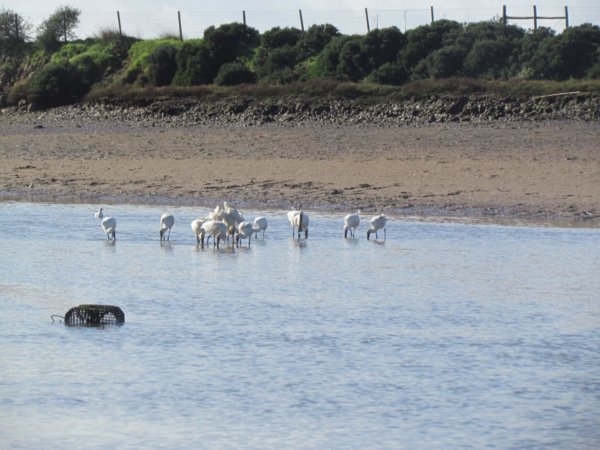
The passage period runs between August and mid-October. Most birds spend winter in Africa (Senegal and Mauritania) and the young birds stay there about 3 years until they reach adult age. Some immatures spend summer in Tunisia where the wintering population has been estimated at 2000- 2500 birds (most birds are present in the Gulf of Gabès, between Sfax and Djerba). Adults winter in Africa and fly back north as soon as January and stay in Iberia before returning to the breeding grounds. They can be found in the Guadalquivir marshes, Cadiz Bay, Ebro delta and Albufeira de Valencia. The number of Spoonbills in Spain in January has increased over the years (12.6% for the period 1991-2005). For the period 1990-2002, there was an average of 1,123 birds and 80% of them in south-western Andalusia, the totals for the other winter months are lower. During the period 2008-10, 1,620 Spoonbills were counted in January. Besides Andalusia, the other wintering grounds of international importance were the Ebro delta and the O Grove Bay. This increase also happened in Portugal. There was an average of 214 birds in January during the period 1993-97 and an average of 1,000 birds during the period 2005-07. Most of these birds were counted in the Algarve where flocks of several hundreds of birds have appeared: Castro Marim and Ria Formosa (which are near the colonies in Huelva). The other passage and wintering sites in Portugal are the Tagus and Sado estuaries and Santo André lagoon. It can also be found on reservoirs in the interior. In spring, birds pass between February and April with a peak in March. Spoonbills are rare in the Azores and Madeira.
Text by Guillaume Réthoré
Photos by Filipa Bragança
If you have any queries please do not hesitate to contact us:
friends.arpt@arocha.org
Or visit us on our open day: Thursdays from 10:15 to 12:00 am
See map: https://arocha.pt/en/contact-us/
GPS coordinates
37°08’39.8″N (37.1444) 8°36’29.2″W (-8.6081)
(+351) 282 968 380
Thank you for supporting us!
Hope to see you soon!


